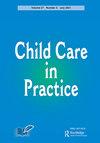Editorial
IF 1.4
Q3 FAMILY STUDIES
引用次数: 0
Abstract
This special edition of Child Care in Practice presents a range of articles that consider how the wellbeing of children on the autism spectrum can be promoted. This is considered from different perspectives and in different settings, including in education and healthcare. A consistent theme is the importance of environmental factors and adaptations that can be made at this level to promote wellbeing, as well as interventions that more directly focus on the individual child. The first two papers in this special edition address important and commonly co-occurring issues associated with autism. In the first paper, Donaghy et al. (2022) present a narrative review of co-occurring physical health issues associated within neurodivergent populations, including Ehlers-Danlos syndrome, Joint hypermobility syndrome, pain, and gastro-intestinal problems. The authors discuss the impact such conditions can have on the educational experiences of children on the autism spectrum, as well as barriers to obtaining appropriate support. The paper provides recommendations for key stakeholders to support such health issues, such as making environmental adaptations (e.g. to accommodate sensory processing differences), interoceptive training for the young people with health conditions, and the need for better awareness of co-occurring health issues for those that support these young people. In the second paper, Dr Nicola Cann (2022) discusses sleep problems in autism, including their aetiology and interventions to address such issues in children and adolescents on the autism spectrum. The author highlights the high prevalence of sleep issues in autism and the impact on quality of life this can have. Sleep issues are also linked to core aspects of difference in autism, such as social relationships and repetitive behaviours, as well as anxiety. The paper concludes that adopting a person-centred and multi-disciplinary approach is essential when working with autistic children and adolescents with sleep issues. The third and fourth papers identify contemporary recommendations for supporting neurodiversity both in medical settings, related to sensory processing challenges individuals with autism may experience, as well as discussing broader implications of supporting neurodiversity for individuals with autism. In the third paper (Williams et al., 2022), one author describes first-hand experience as an autistic individual receiving inpatient mental health services as an adolescent, while another is an adoptive parent of children with complex needs as well as a licensed psychotherapist specializing in children and family issues. The paper also discusses differences between traditional person-first terminology and identity-first language utilized throughout the paper, as does the fourth paper, through a contemporary lens. Through qualitative research methodology, the authors detail aspects of inpatient hospital stays that can be particularly aversive for autistic individuals from a sensory perspective, as well as identified accommodations and solutions that may decrease the stress level for the autistic individual. The fourth paper (Izuno-Garcia et al., 2022) discusses the neurodiversity movement moving from person-first to identify-first language for some autistic self-advocates and reasons for such a paradigm shift. Additionally, the paper details contemporary challenges from an autistic individual as well as family perspective on the facilitators and barriers in the evaluation process to arrive at a diagnosis, disclosure of diagnosis to adolescents and recent research on quality of life into adulthood with receiving a diagnosis as a child or编辑
本期《实践中的儿童护理》特别版提供了一系列关于如何促进自闭症儿童福祉的文章。这是从不同的角度和在不同的环境中考虑的,包括在教育和保健方面。一个一致的主题是环境因素和适应的重要性,可以在这个层面上促进福祉,以及更直接地关注儿童个体的干预措施。本特别版的前两篇论文讨论了与自闭症相关的重要和常见的问题。在第一篇论文中,Donaghy等人(2022)对神经分化人群中共同发生的身体健康问题进行了叙述性回顾,包括Ehlers-Danlos综合征、关节过度活动综合征、疼痛和胃肠道问题。作者讨论了这些条件可能对自闭症儿童的教育经历产生的影响,以及获得适当支持的障碍。该文件为主要利益攸关方提供了支持此类健康问题的建议,例如进行环境适应(例如,适应感觉处理差异),对有健康状况的年轻人进行内感受性培训,以及需要更好地认识支持这些年轻人的人同时发生的健康问题。在第二篇论文中,Nicola Cann博士(2022)讨论了自闭症患者的睡眠问题,包括其病因和干预措施,以解决自闭症儿童和青少年的这些问题。作者强调了自闭症患者普遍存在的睡眠问题及其对生活质量的影响。睡眠问题也与自闭症的核心差异有关,比如社会关系、重复行为以及焦虑。该论文的结论是,在治疗有睡眠问题的自闭症儿童和青少年时,采用以人为本和多学科的方法是必不可少的。第三篇和第四篇论文确定了在医疗环境中支持神经多样性的当代建议,这些建议与自闭症患者可能遇到的感觉处理挑战有关,并讨论了支持自闭症患者神经多样性的更广泛含义。在第三篇论文中(Williams et al., 2022),一位作者描述了作为一名自闭症患者在青少年时期接受住院心理健康服务的第一手经验,而另一位作者是有复杂需求的儿童的养父母,也是一名专门研究儿童和家庭问题的有执照的心理治疗师。本文还讨论了传统的个人第一术语和身份第一语言之间的差异,贯穿全文,第四篇论文也是如此,通过当代的视角。通过定性研究方法,作者从感官角度详细介绍了住院患者对自闭症患者特别反感的方面,并确定了可能降低自闭症患者压力水平的住宿和解决方案。第四篇论文(Izuno-Garcia et al., 2022)讨论了一些自闭症自我倡导者从个人优先到识别优先语言的神经多样性运动,以及这种范式转变的原因。此外,本文还从自闭症个体和家庭的角度详细介绍了在诊断评估过程中的促进因素和障碍,向青少年披露诊断,以及最近关于儿童或儿童接受诊断后成年生活质量的研究
本文章由计算机程序翻译,如有差异,请以英文原文为准。
求助全文
约1分钟内获得全文
求助全文
来源期刊

Child Care in Practice
Nursing-Community and Home Care
CiteScore
3.30
自引率
5.30%
发文量
32
期刊介绍:
Child Care in Practice is a quarterly, peer-reviewed journal that provides an international forum for professionals working in all disciplines in the provision of children’s services, including social work, social care, health care, medicine, psychology, education, the police and probationary services, and solicitors and barristers working in the family law and youth justice sectors. The strategic aims and objectives of the journal are: • To develop the knowledge base of practitioners, managers and other professionals responsible for the delivery of professional child care services. The journal seeks to contribute to the achievement of quality services and the promotion of the highest standards. • To achieve an equity of input from all disciplines working with children. The multi-disciplinary nature of the journal reflects that the key to many successful outcomes in the child care field lies in the close co-operation between different disciplines. • To raise awareness of often-neglected issues such as marginalization of ethnic minorities and problems consequent upon poverty and disability. • To keep abreast of and continue to influence local and international child care practice in response to emerging policy. • To include the views of those who are in receipt of multi-disciplinary child care services. • To welcome submissions on promising practice developments and the findings from new research to highlight the breadth of the work of the journal’s work.
 求助内容:
求助内容: 应助结果提醒方式:
应助结果提醒方式:


